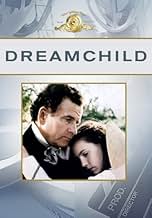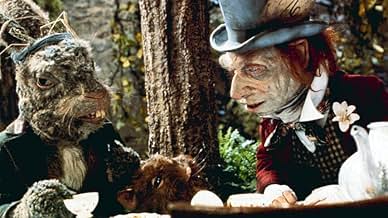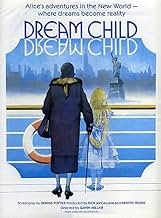Ian Holm é o autor infantil Lewis Carroll neste comovente drama de fantasia na década de 1930 em Nova Iorque e povoado pelas fabulosas criaturas de efeitos especiais do mestre dos Marretas J... Ler tudoIan Holm é o autor infantil Lewis Carroll neste comovente drama de fantasia na década de 1930 em Nova Iorque e povoado pelas fabulosas criaturas de efeitos especiais do mestre dos Marretas Jim Henson.Ian Holm é o autor infantil Lewis Carroll neste comovente drama de fantasia na década de 1930 em Nova Iorque e povoado pelas fabulosas criaturas de efeitos especiais do mestre dos Marretas Jim Henson.
- Direção
- Roteirista
- Artistas
- Indicado para 2 prêmios BAFTA
- 7 vitórias e 6 indicações no total
- Radio Sound Effects Man
- (narração)
- …
Avaliações em destaque
The main narrative has Alice Liddell, now the nearly-80-years-old and widowed Mrs. Hargreaves, traveling to New York to receive an honorary degree to mark the centenary of Lewis Carroll's birth. While in the states, she's hounded by the press (the gaggle of fast-talking, cynical Depression-era reporters being an imitation straight out of "The Front Page") and forced to recall her childhood encounters with Mr. Dodgson and selections from the book he wrote for her. Underlying the dreams from book is a competent interpretation of "Alice's Adventures in Wonderland." Beyond the amusing nonsense, the fictional Alice's physical transformations--alternately growing bigger and smaller--is translated as an allegory for aging, with the movie's Alice changing between her as a child and as an old woman in her interactions with Wonderland's inhabitants. These characters remain partially nasty or threatening to Alice, as per the literary source, which likewise is read as representing one's (originally, a child's) struggle to make sense of the adult world, or, in this case, also the Depression-era modernity of the New World and Alice's reckoning with her past relationship with the author.
All of this is reflected in two plotlines involving older men and their advances towards younger females. In the modern timeline, one of the reporters begins a romantic relationship with Alice's travel companion, Lucy, and, in the past, there's Dodgson's questionable intentions towards young Alice. "Dreamchild" largely reduces the author of the greatest books in the history of children's literature to a stuttering girl lover who seems to repress his sexual desires with photography and telling her stories, disregarding much of his other influences and importance of his work, but it's a more sophisticated interpretation of the Alice books than most other movies I've sought out since reading Carroll's stories, and it's certainly one of the more unsettling and mature reimaginings.
Four actresses stand out in my memory - Coral Browne as the starchy old Alice - Amelia Shankley as the young selfcentered Alice - Nicola Cowper as old Alices companion and love interest to the young American reporter played by Peter Gallagher - and - in a small role - Caris Corfman as a wistful newspaper reporter - in addition to many fine British and American actors
My only gripe is Ian Holm's age - Holm was in his early 50s when he portrayed Lewis Carroll - who was closer to 30 when he first told the stories - there were concerns in his time about the purity of his interest in his child friends and photography subjects - such as Alice - Ian Holm brings that frightfully to life
This film took great care in evoking the respective time periods - using beautiful set designs and photography - as a result - the movie is itself an exotic journey into other times and places - with Alice still as protagonist
I suppose a large part of my initial negative reaction was due to the film's puzzling failure to capture a fundamental aspect of Alice Liddell's childhood personality. Alice spent much of her time in "Wonderland" being p .d off; at the illogic, the rudeness, and the selfishness of the characters she met there. Both Alice's were proper and confident little Victorian girls who took themselves very seriously. I am sure that this was one of many "Real Alice" personality traits that Carroll transplanted to his "Wonderland" Alice. Often amused by her reactions of irritation and frustration, he constructed many of the story elements with the intention of getting indigent reactions from Alice and her sisters. I had hoped that this connection would be made by the film and was disappointed that it was not explored, although in retrospect you could argue that the older Alice's reactions to the characters she meets in America are identical to Alice's reactions to the characters in Wonderland. That the film does not explore my pet topic was disappointing but ultimately not fatal.
In all other respects the portrayal of young Alice Liddell was excellent. Amelia Shankley turned in a fine performance. She is clearly the best film Alice so far and it is a shame that they did not star her in an actual Alice film right after "Dreamchild" was completed. And Coral Browne was equally excellent as the older Alice.
This film is about how Alice's mother (who felt her daughter could find much better candidates for marriage as she moved into her teens) essentially poisoned her memories of Dodgson, leading her to believe that there was something wrong about his feelings for her (when in fact he was just a childlike personality who loved her more than his other child friends, but always with a shy innocence). It is also about the guilt the older Alice still feels over abandoning him just as she entered her teens, especially after all the innocent kindness he had shown. She is in denial about her affection for Dodgson and irritated because all the attention of his centennial is forcing her to recall those long-suppressed years of her life. And finally she feels that since she was not actually the little heroine who exhibited so much courage in "Wonderland", she does not deserve her sudden celebrity status. In her view she was catapulted into fame "by simply doing nothing". Remember that Wonderland Alice is arguably the bravest literary heroine of all time.
What ultimately redeems the film is the climatic scene in the hall of Columbia University. Alice Liddell flashes back to a scene late in her relationship with Dodgson, a symbolic scene meant to represent the end of their relationship. She had outgrown him at this point in her life and she laughs and humiliates him as he attempts to sing his Lobster Quadrille song to the three Liddell sisters and their male suitors. When her mind returns to the present she hears the Columbia University orchestra and glee club performing the same song. She realizes that the story which she once rejected was in fact his personal tribute to her and that even after all these years each little detail of his creation is admired throughout the world. At this point she finally gets it. She goes back to the symbolic scene as her older sister Lorina reads the final paragraph from the Wonderland book, the one in which Dodgson reveals the reason he made up the story. Then the child Alice walks over, kisses Dodgson in apology, and places her head on his chest (an omission for which she has long felt guilty). Then we are back in the hall and find that in place of her prepared speech she has read this same passage to the now applauding crowd.
The point is that she finally understood that the story was a gift to her and to future generations of children, that she had inspired the story and had been the model for his heroine. With this realization came the final gift of knowing that the virtues Mr. Dodgson gave his heroine: innocence, courage, curiosity, wonder, kindness, intelligence, courtesy, humor, dignity, and a sense of justice; were virtues he credited to the real Alice.
It is hard to imagine a better scene (or sequence of scenes) than the climatic one detailed above. Film and video cannot hope to compete with books in communicating thoughts. But with the right players film can visually communicate moments of character realization and transformation to a degree much more subtle and personal than what any author can write. This is the real magic of film and acting for the camera. In the end these climatic moments say everything that needs be said about the relationship between Dodgson and his "dreamchild". A truly great cinematic moment and my all-time favorite.
Você sabia?
- CuriosidadesBecause its American theatrical release was limited, and she was extremely proud of this movie, Coral Browne went on a self-funded promotional tour.
- Erros de gravaçãoDuring the tea dance Jack and Lucy waltz to "I Only Have Eyes For You." The scene is set in 1932, but the song was not written until 1934.
- Citações
Alice Hargreaves: That's quite intolerable. It would be difficult enough at my age to be what I once was, but utterly impossible to be what I never was.
- ConexõesFeatured in At the Movies: The Trip to Beautiful/Ran/Clue/Dreamchild (1985)
- Trilhas sonorasAll of Me
(uncredited)
Music by Gerald Marks
Lyrics by Seymour Simons
Performed by a vocalist with the ship's band
Principais escolhas
- How long is Dreamchild?Fornecido pela Alexa
Detalhes
Bilheteria
- Orçamento
- £ 4.000.000 (estimativa)
- Faturamento bruto nos EUA e Canadá
- US$ 1.215.923
- Fim de semana de estreia nos EUA e Canadá
- US$ 5.425
- 6 de out. de 1985
- Faturamento bruto mundial
- US$ 1.215.923


































